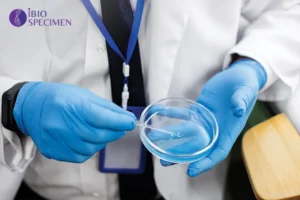- +1 (408)580-1396
- info@iBioSpecimen.com
Best Practices for Storing FFPE Liver Disease Tissue Blocks?
- August 1, 2023
Welcome to our blog post on the best practices for storing FFPE liver disease tissue blocks. Proper storage is crucial for preserving these valuable samples and ensuring their quality for future research or diagnostic purposes. In this article, we will explore the optimal storage conditions, packaging and labeling techniques, efficient organization and inventory management strategies, as well as guidelines for retrieval and transportation of FFPE liver disease tissue blocks. Let’s dive in!
Best Practices for Storing FFPE Liver Disease Tissue Blocks
To ensure the integrity of FFPE liver disease tissue blocks, proper storage practices must be implemented. Firstly, it is essential to store the blocks in a controlled environment with stable temperature and humidity levels. Additionally, using specialized containers that are resistant to water and chemical exposure will help to prevent degradation of the tissue and RNA molecules within. Regular monitoring and documentation of storage conditions are crucial for maintaining sample quality over time.
Understanding FFPE Liver Disease Tissue Blocks
FFPE liver disease tissue blocks are composed of formalin-fixed, paraffin-embedded (FFPE) liver tissues. These blocks undergo a series of processing steps, including fixation with formalin and embedding in paraffin wax, to preserve the structure and integrity of the tissue. This process allows for long-term storage and subsequent analysis of the tissue’s RNA content.
FFPE liver disease tissue blocks are a valuable resource for researchers due to their stability and widespread availability. These blocks preserve the structure and integrity of liver tissues, allowing for long-term storage and analysis of the RNA content. However, it is important to note that the fixation process may affect RNA quality, leading to potential limitations in downstream analyses.
The advantages of using FFPE liver disease tissue blocks lie in their stability and availability. The fixed nature of these tissues ensures that they can be stored for extended periods without significant degradation. Additionally, FFPE liver disease tissue blocks are widely accessible as they can be obtained from various sources such as biobanks or pathology laboratories.
However, it is important to note that there are limitations associated with using FFPE liver disease tissue blocks for RNA analysis. The fixation process may result in cross-linking between nucleic acids and proteins, which can affect the quality and quantity of extracted RNA. Furthermore, variations in sample handling techniques during processing may introduce bias or inconsistencies in downstream analyses.
In conclusion, understanding the composition and processing steps involved in creating FFPE liver disease tissue blocks is crucial for researchers working with these samples. While there are advantages to utilizing this storage method due to its stability and availability, it is essential to consider the limitations imposed by potential RNA degradation or variability introduced during sample preparation processes
Importance of Proper Storage
Preserving the integrity and quality of FFPE liver disease tissue blocks is crucial in order to ensure accurate results in subsequent analyses or experiments. Proper storage techniques are essential for preventing degradation or loss of important biomolecules, such as RNA, which play a vital role in research. By implementing best practices and maintaining optimal conditions, researchers can maximize the longevity and usability of stored FFPE liver disease tissue blocks, ultimately enhancing the reliability and validity of their findings.
Storage Conditions for FFPE Liver Disease Tissue Blocks:
- Temperature and humidity control is crucial for preserving the integrity of FFPE liver disease tissue blocks. It is recommended to store these blocks in a temperature-controlled environment, ideally between 20-25°C, with a relative humidity of 40-60%.
- To ensure optimal storage conditions, it is important to avoid temperature fluctuations that could potentially damage the tissue blocks. Sudden changes in temperature can lead to condensation and moisture buildup, compromising the quality of the samples.
- Moisture damage can have detrimental effects on FFPE liver disease tissue blocks. Therefore, it is essential to protect them from any sources of moisture or water exposure by placing them in sealed containers or bags with desiccants.
- Exposure to light can also negatively impact the stability and longevity of FFPE liver disease tissue blocks. Hence, they should be stored away from direct sunlight or artificial light sources that emit UV radiation.
By adhering to these best practices for storing FFPE liver disease tissue blocks, you can ensure their long-term preservation and maintain their suitability for future analysis and research purposes
Temperature and Humidity Control
Maintaining a temperature of -20°C to -80°C is crucial for storing FFPE liver disease tissue blocks. This ensures the preservation of cellular structures and DNA integrity. Monitoring humidity levels below 50% helps prevent moisture damage, which can lead to degradation of the tissue samples. Using specialized storage units with temperature and humidity controls provides optimal conditions for long-term preservation, ensuring the quality and reliability of the stored FFPE liver disease tissue blocks.

Avoiding Temperature Fluctuations
Regularly checking and calibrating storage unit temperatures ensures consistent cooling for FFPE liver disease tissue blocks. By minimizing the opening of the storage unit, temperature fluctuations can be prevented, maintaining optimal conditions for preservation. Thoughtful placement of tissue blocks within the unit further optimizes cooling and minimizes temperature variations, ensuring the integrity of samples over time.

Protecting Against Moisture Damage
Properly sealing containers or bags holding tissue blocks is crucial in protecting against moisture damage. By ensuring a tight seal, you can prevent any moisture from entering and compromising the integrity of the tissue blocks.

To further protect against moisture damage, consider using desiccants like silica gel in storage containers. These absorbent materials effectively remove excess moisture and help maintain optimal conditions for storing FFPE liver disease tissue blocks.
Don’t forget to periodically inspect stored tissue blocks for signs of moisture damage. Early detection allows for prompt action, preventing further deterioration and preserving the quality of the samples. Stay vigilant to ensure long-term preservation.
Preventing Exposure to Light
Storing FFPE liver disease tissue blocks in light-resistant containers or wrapping them with aluminum foil can prevent exposure to light. This is important because light can degrade the quality of the samples and affect the accuracy of subsequent analyses. Avoiding direct exposure to sunlight or fluorescent lights when handling the blocks is also crucial, as even brief exposure can have damaging effects. It is recommended to frequently monitor storage areas for any potential light leaks to ensure that the samples remain protected at all times.
- Store FFPE liver disease tissue blocks in light-resistant containers.
- Wrap them with aluminum foil for added protection.
- Avoid direct exposure to sunlight or fluorescent lights.
- Monitor storage areas regularly for any potential light leaks.
Packaging and Labeling FFPE Liver Disease Tissue Blocks
Packaging and labeling FFPE liver disease tissue blocks is crucial for maintaining their integrity. When storing these blocks, it is best to use airtight containers to prevent any moisture or contaminants from affecting the samples. Additionally, proper labeling and documentation should be implemented to ensure accurate identification and tracking of each block. By following these best practices, researchers can preserve the quality of FFPE liver disease tissue blocks for future analysis and study.

Using Airtight Containers
Using airtight containers is crucial for preserving tissue integrity when storing FFPE liver disease tissue blocks. These containers create a barrier against air, moisture, and contaminants that can compromise the quality of the samples over time. It is important to choose airtight containers specifically designed for FFPE tissue storage, such as screw-cap vials or snap-top tubes with rubber gaskets. When selecting the right container, factors like size, material compatibility, and ease of handling should be considered to ensure optimal preservation conditions for the valuable liver disease tissue samples.
Avoiding Cross-Contamination
- Prevent contamination between different tissue samples
- Use proper handling techniques to minimize cross-contamination risks
- Implement strict protocols for cleaning and disinfecting storage areas.
Proper Labeling and Documentation
Importance of accurate labeling on FFPE liver disease tissue blocks cannot be overstated. Properly labeled specimens ensure traceability and prevent mix-ups, contributing to reliable research outcomes. Including essential information such as patient ID and date on labels is crucial for identification and organization purposes. Moreover, maintaining detailed documentation through record-keeping practices allows for easy retrieval of pertinent data when needed, promoting efficient analysis and collaboration among researchers.
Efficient Organization and Inventory Management
Efficient organization and inventory management are crucial for storing FFPE liver disease tissue blocks. Developing a systematic storage system ensures easy access to specific samples, reducing retrieval time and minimizing the risk of misplacement. Implementing a digital inventory management system allows for real-time tracking of sample locations, eliminating manual record-keeping errors. Regular monitoring and maintenance ensure the integrity of stored tissue blocks, preventing any degradation or loss in quality over time. By following these best practices, researchers can optimize their workflow and enhance the reliability of their research outcomes.
Developing a Systematic Storage System
Categorizing tissue blocks based on disease type allows for efficient retrieval and analysis. By creating a labeling system for easy identification, researchers can quickly locate the desired FFPE liver disease tissue block. Establishing standardized storage procedures ensures the integrity and longevity of the samples.
- Categorize tissue blocks based on disease type
- Create a labeling system for easy identification
- Establish standardized storage procedures
Implementing a Digital Inventory Management System
Choosing the right software for inventory tracking is crucial in implementing a digital inventory management system. It should have features that allow easy tracking, updating, and retrieval of information about each tissue block. Additionally, digitizing key information about each tissue block improves efficiency by eliminating the need for manual record-keeping and reducing human error.
Integrating barcode or RFID technology for efficient scanning further enhances the effectiveness of a digital inventory management system. This enables quick identification and recording of tissue blocks during storage or retrieval processes. By streamlining these tasks, time is saved and accuracy is improved, ensuring optimal organization and traceability within the inventory management system.
Regular Monitoring and Maintenance
Regular Monitoring and Maintenance is crucial for ensuring the long-term preservation of FFPE liver disease tissue blocks. By performing routine inspections, you can quickly identify any signs of damage or deterioration, allowing for timely intervention to prevent further degradation. Maintaining appropriate temperature and humidity levels in the storage area is essential to preserve the integrity of these precious samples. Additionally, ensuring proper security measures are in place helps safeguard against unauthorized access that could compromise the quality and reliability of stored FFPE liver disease tissue blocks.
- Performing routine inspections to check for any signs of damage or deterioration
- Maintaining appropriate temperature and humidity levels in the storage area
- Ensuring proper security measures are in place to prevent unauthorized access
Retrieval and Transportation of FFPE Liver Disease Tissue Blocks:
To ensure the integrity of FFPE liver disease tissue blocks during retrieval and transportation, proper handling techniques must be followed. This includes using sterile gloves to prevent contamination and carefully labeling each block with relevant information.
Safe transport procedures are crucial for preserving the quality of FFPE liver disease tissue blocks. Utilizing insulated containers with temperature control mechanisms can help maintain optimal conditions throughout the journey, preventing sample degradation.
Minimizing sample degradation is essential when retrieving and transporting FFPE liver disease tissue blocks. Implementing a rapid retrieval process minimizes exposure time to external factors, while utilizing specialized packaging materials that provide protection against mechanical stress further safeguards the samples’ structural integrity.
Proper Handling of Tissue Blocks
Gentle and careful handling is essential to avoid tissue damage when working with tissue blocks. By using a delicate touch, you can ensure that the integrity of the sample is preserved throughout the manipulation process. It is also crucial to wear appropriate personal protective equipment (PPE) such as gloves and lab coats to prevent contamination and protect both yourself and the sample. Additionally, always use clean, sterile instruments for any manipulation of tissue blocks in order to maintain aseptic conditions and minimize potential sources of contamination.
Safe Transporting Procedures
Packaging the tissue blocks securely in leak-proof containers is essential to ensure their safe transportation. This prevents any leakage or contamination that may occur during transit. Additionally, maintaining proper temperature conditions during transportation is crucial for preserving the integrity of the tissue blocks. This helps prevent degradation and ensures accurate results upon analysis. Lastly, labeling the containers with necessary information such as patient ID and sample type allows for easy identification and traceability throughout the transport process.
- Securely package tissue blocks in leak-proof containers
- Maintain proper temperature conditions during transportation
- Label containers with patient ID and sample type information
Minimizing Sample Degradation
Storing tissue blocks in a well-ventilated area away from direct sunlight or heat sources ensures their preservation. By maintaining proper airflow and reducing exposure to high temperatures, the risk of sample degradation is minimized. Monitoring humidity levels is also crucial as excessive moisture can lead to degradation of tissue samples. Regularly inspecting for signs of mold or other contaminants helps identify potential issues early on, allowing for prompt action to prevent further deterioration. With these practices in place, the integrity and quality of FFPE liver disease tissue blocks can be safeguarded for future analysis and research purposes.
Conclusion
Proper storage is crucial for preserving FFPE liver disease tissue blocks. By following best practices, such as maintaining optimal temperature and humidity levels, we can ensure the long-term preservation of these valuable samples. Moreover, future research possibilities in this field are vast, ranging from investigating novel storage methods to exploring new techniques for analyzing FFPE liver disease tissue blocks. By prioritizing proper storage and investing in further research, we can unlock a wealth of knowledge to advance our understanding and treatment of liver diseases.



